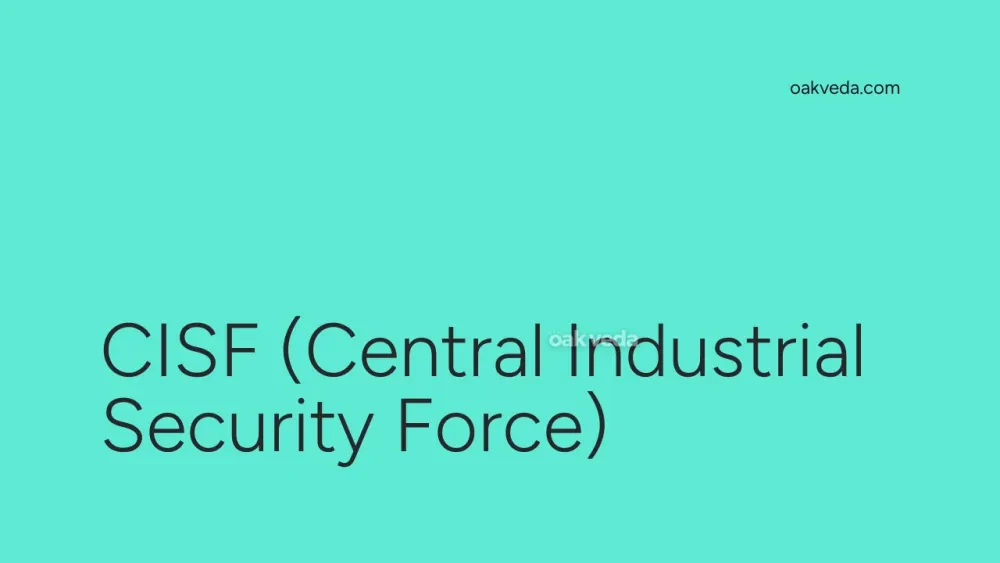
What is the Full Form of CISF?
The full form of CISF is Central Industrial Security Force. This organization plays a crucial role in safeguarding India's industrial and critical infrastructure assets.
What is Central Industrial Security Force?
The Central Industrial Security Force (CISF) is a premier paramilitary force in India, operating under the Ministry of Home Affairs. Established in 1969, it has evolved into one of the largest industrial security forces globally, with a strength of approximately 170,000 personnel across 132 battalions. The CISF's headquarters is located in New Delhi, India's capital city.
Origin and Development of Central Industrial Security Force
The CISF was founded on March 10, 1969, through an Act of the Indian Parliament. Its primary objective was to provide security to industrial units, government infrastructure installations, and other critical facilities across the country. Over the years, the CISF has expanded its scope and responsibilities, adapting to the changing security landscape of India.
How does Central Industrial Security Force work?
The CISF operates through a well-structured organizational framework. It is divided into three main branches:
- Executive Branch: Handles core security operations
- Fire Service Division: Manages fire safety and emergency response
- Ministry Branch: Oversees administrative functions
Additionally, the CISF is organized into six sectors, each headed by a Sector Inspector General:
- Northern Sector (Headquarters: New Delhi)
- Southern Sector (Headquarters: Chennai)
- Western Sector (Headquarters: Mumbai)
- Eastern Sector (Headquarters: Patna)
- North-Eastern Sector (Headquarters: Kolkata)
- Central Sector (Headquarters: Hyderabad)
This structure allows for efficient management and deployment of personnel across the country.
Functions of Central Industrial Security Force
The CISF's primary functions include:
- Providing security to industrial units and critical infrastructure
- Protecting government buildings and installations
- Offering fire protection services
- Securing major airports and metro systems
- Providing consultancy services on security matters
- Conducting anti-sabotage checks
- Assisting in disaster management operations
Applications of Central Industrial Security Force
The CISF's expertise is applied across various sectors:
- Industrial Security: Protecting public and private sector industries
- Aviation Security: Safeguarding airports and ensuring passenger safety
- Metro Rail Security: Securing metro systems in major cities
- Government Building Security: Protecting important government installations
- Disaster Management: Assisting in rescue and relief operations during natural calamities
- VIP Security: Providing protection to designated VIPs
Features of Central Industrial Security Force
Key features of the CISF include:
- Specialized Training: Personnel undergo rigorous training in various aspects of security
- Advanced Technology: Utilization of modern security equipment and surveillance systems
- Adaptability: Ability to handle diverse security challenges across different sectors
- Consultancy Services: Offering expert advice on security matters to various organizations
- Gender Diversity: Inclusion of women personnel in various roles
- Rapid Response Teams: Specially trained units for quick deployment in emergencies
Benefits of Central Industrial Security Force
The CISF provides numerous benefits to the nation:
- Enhanced Industrial Security: Ensures the safety of critical industrial assets
- Economic Growth: Contributes to a secure environment for industrial development
- Public Safety: Protects citizens in public spaces like airports and metro stations
- Expertise Sharing: Offers valuable security insights to other organizations
- Emergency Response: Provides crucial support during disasters and crises
- National Security: Plays a vital role in the overall security framework of the country
Limitations or Challenges of Central Industrial Security Force
Despite its strengths, the CISF faces certain challenges:
- Manpower Shortage: Increasing demand for services strains available personnel
- Technological Advancements: Constant need to upgrade skills and equipment
- Diverse Threat Landscape: Adapting to evolving security challenges
- Work-Life Balance: Long working hours and high-stress environments for personnel
- Coordination with Local Authorities: Ensuring smooth cooperation with state police forces
Future Developments in Central Industrial Security Force
The CISF is continuously evolving to meet future challenges:
- Artificial Intelligence Integration: Exploring AI-based security solutions
- Drone Technology: Incorporating drones for surveillance and security operations
- Cybersecurity Focus: Expanding capabilities to protect against cyber threats
- Green Initiatives: Adopting eco-friendly practices in its operations
- International Cooperation: Enhancing collaboration with global security agencies
FAQs on CISF Full Form
-
What is the full form of CISF? The full form of CISF is Central Industrial Security Force.
-
When was CISF established? CISF was established on March 10, 1969.
-
What is the primary role of CISF? The primary role of CISF is to provide security to industrial units, critical infrastructure, and government installations.
-
How many personnel does CISF have? CISF has approximately 170,000 personnel.
-
Does CISF provide security at airports? Yes, CISF is responsible for security at most major airports in India.
-
Can private organizations hire CISF services? Yes, CISF provides consultancy services to private organizations on security matters.
-
Is CISF involved in disaster management? Yes, CISF assists in disaster management and relief operations during natural calamities.
You may be interested in:

